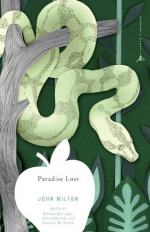|
This section contains 1,489 words (approx. 5 pages at 300 words per page) |

|
The Unholy Trinity as a Reverse Allegory
Summary: Essay shows how the Unholy Trinity of Satan, Sin, and Death in "Paradise Lost" written by John Milton is an example of a perverse allegory of the Holy Trinity of God, the Son, and the Holy Spirit.
Edward Spencer celebrated allegorical writing with his classic romantic epic "The Faerie Queen." Even as Milton criticized the use of allegory, he indubitably implemented the use of it in "Paradise Lost." Although Milton does use allegory, his use of the form tremendously differs from that of Spencer. His application of allegory is a reversal of the typical Spenserian allegory.
Milton uses a reverse allegory as an abstract representation of the Holy Trinity of God, the Son, and the Holy Spirit by an Unholy Trinity of Satan, Sin and Death. As indicated by Webster's Revised Unabridged Dictionary, an allegory is: "a figurative sentence or discourse, in which the principle subject is described by another subject resembling in its properties and characteristics. The real subject is kept out of view and we are left to collect the intentions of the writer or speaker by the resemblance of the secondary to...
|
This section contains 1,489 words (approx. 5 pages at 300 words per page) |

|


